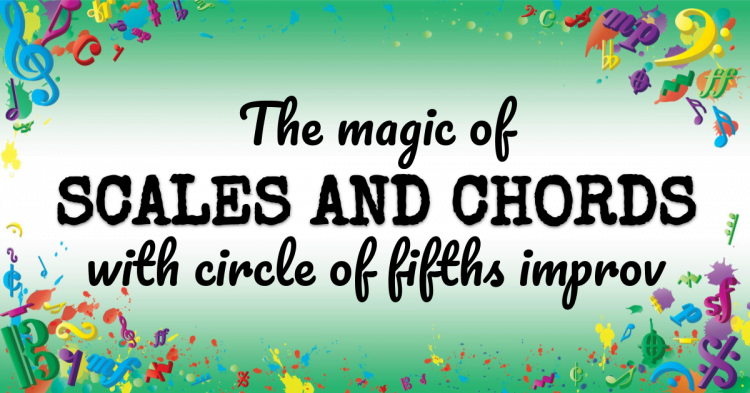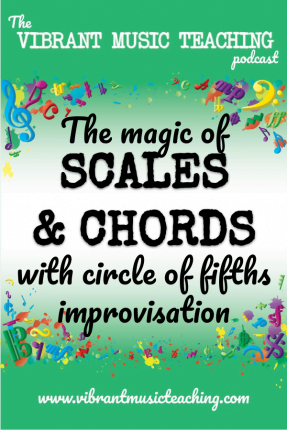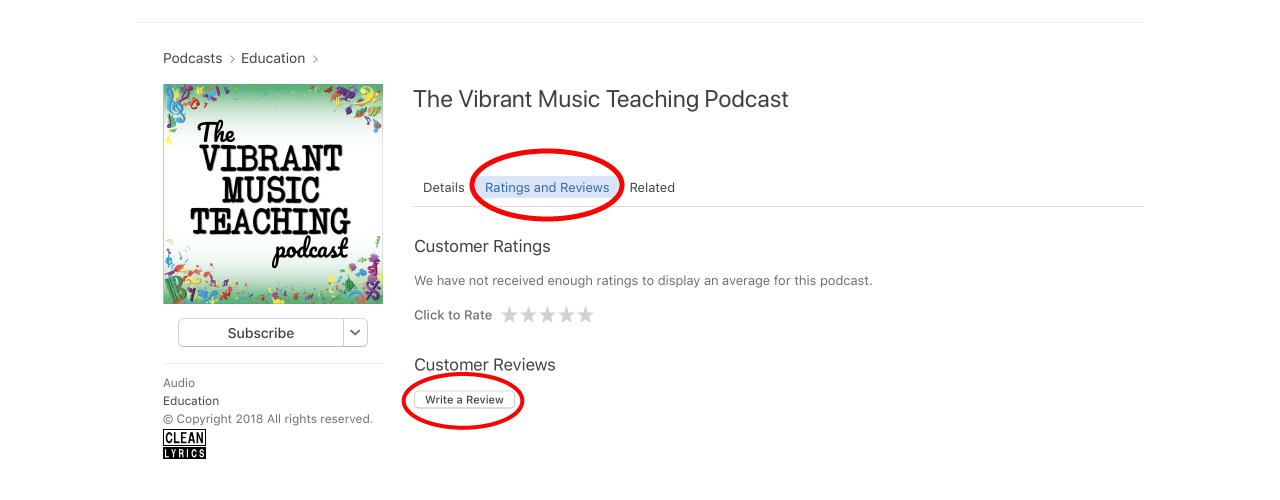The circle of fifths is a very useful tool to bring all of the key signatures together and reveal their relationships to each other. But how can we help students to understand this? How can we allow them to feel the magic? That’s where improvising your way around the circle of fifths can be so useful. Find out how today.


Relevant Resources
Full Transcript
Click on any word to jump to that point in the audio. 🙂
VMT 014 – How to reveal the magic of scales & chords with circle of fifths improv.mp3
Vibrant vibrant vibrant music teaching proven and practical tips strategies and ideas for music teachers.
Welcome to Episode 14 of the vibrant music teaching podcast. I’m Nicola Cantan. And in this episode I want to give you the why behind my new course the circle of fifths odyssey.
Beautiful teachers today I want to talk about the circle of fifths and in particular I want to share with you a new way that I’ve been using the circle of fifths in my studio this past year or so. But first for those of you who aren’t familiar let me just explain what the circle of fifths actually is because this is taught in some parts of the world. Not so much in others. So the circle of fifths is simply the pattern we get when we go up in perfect fifths. So we go from C to g to d to a etc. around and that creates this circle of fifths when we get back to see this pattern means that we’re moving up one sharp at a time. Or if we go the other way we’re moving up one flat at a time and it’s a really convenient way to learn about various things because it also means that the tonic and dominant and subdominant are beside each other. And if you arrange the minor circle of fifths inside you’ve got the relative minors of all of those as well. So it’s a really convenient way to look at key signatures and their structure. Now I didn’t really know about the circle of fifths myself until I was probably about 18 or 19 which is incredible to me because I learnt all of the scales in this order but I didn’t realize what I was doing and I never saw it in this circle format in this format that looks a bit like a clock and it really revealed a ton of stuff to me when I did. So I want to bring that to my students a lot sooner. Now I’ve been referring to the circle of fifths for many years now my teaching and I actually put it at the top of my assignment sheets which I use with older beginners teen students and adult students that I use with all of them.
So they see the circle of fifths regularly. But the last year I started thinking about a new way to reveal this to them because what I wanted them to be able to do was to see it as the magic formula or magic pattern that I saw as because it has all these beautiful relationships contained within it. And I didn’t get that as I say until I finally met it when I was about 18 19 20 somewhere around there. So I wanted to reveal that magic to my students earlier and I didn’t want to do it by showing them the circle of fifths and explaining and pointing out all of their relationships. Sure I can do that later and I can refer back to it multiple times. But I wanted them to actually understand it on a more intuitive level. And that’s where I came up with the idea of improvising our way around the circle of fifths. Now why improvisation. Well to me improvising together with another person especially can allow you to understand things in a way that you wouldn’t otherwise. It can allow you to feel a key and the underlying structure and what scales are for and all of that good stuff. So it’s not about reading a key signature it’s about feeling it. And that’s really what I wanted for my students too many students. I feel end up thinking that key signatures with lots of black keys in them are hard.
And I felt that way too but they’re not are they is G flat major. Actually harder than C major. No in a lot of ways it’s actually easier to find your way around. It’s certainly easier to find your way around than say a major which has this huge mix of white and black keys. And it’s more comfortable to play in than many other keys but because we focus on reading or at least I did growing up I never saw it that way. Not for a long time not until I started having to play tons of teacher duet parts that were all in the key of G flat so I don’t want my students to think that these black key key signatures. The ones with lots of sharps or lots of flats are unnecessarily hard. They might be a little bit trickier to read. In some cases but they’re mostly that way because students don’t have the feeling of the key.
And yes they can get that using scales but that’s such an unmusical experience. In many cases the way we teach scales and often students aren’t really relating one to the other. So it ends up being this kind of fractured experience until it all finally comes together once I get to a certain stage. But they have to get to that certain stage and if we don’t get them to this understanding sooner. My fear is that they’ll quit before they get to see how it all comes together and how everything fits into place there still will be some things that they won’t fully understand. But I think we can bring the process back. That little bit earlier and make them feel what it feels like to play in a key and how these things fit together and how the sharps and flats build up and how they relate to each other and how scales relate to chords and all of that good stuff. So that’s what my goal is with improvising around the circle of fifths I want them to feel that black and white keys are all the same that they all fit together and that one key signature is not completely different to another one. It’s just another way to make music. It’s another way to construct it so how it works in my studio and how it works in the circle of fifths Odyssey plans is that we start with C major and I simply introduce to the student.
Okay we’re going to play an improvisation together in the key of C and then I say. Now what does that mean for different students. Give you a different answer here. It depends what stage they’re up. But it also depends on the way they think. So some will immediately tell me Well it means I play all the white keys which is the answer that I actually want but some will tell me it means I can play from the C to this C because they thought about buying a scale in that particular octave and I say no you can play all of the keys as long as you don’t steal mine. The ones I’m using for the accompaniment so they come up with different answers but eventually we land on the fact that basically just don’t play the Black Keys. That’s the solution. Everything else will sound pretty much okay so we give that a go and they experience it and then I say now we’re going to go to G major and do the same process there. Okay what does that mean. Now they’re familiar with their scales. They might immediately tell me well but has one sharp in it or they might show me the full scale or some other solution.
But eventually we land on the fact that yeah there’s one sharp sharp we’re not going to play anymore. F is going to the end of it. Yucky a bit weird or a bit off. So we try out G major and often at this stage they will play an F by mistake which I actually love seeing them do because they make this face and they totally get how we’re in that key and how why I’ve had them play as F sharp instead of F. It’s not just me telling them Well these are the rules and do this. It’s about them hearing it and feeling oh no I don’t really like the sound of that. At this point after G Major I’ll ask them to look around the room and see if they can tell me what the next key is because behind us on the wall in my studio we have a circle of fifths so that look around and eventually they will find the C and the G and conclude that d is going to be next and we’ll talk about the fact that we’re going to add on a new sharp. I like to phrase it that way to make it really clear that they are not remembering all the sharps in every key they are building on them.
They’re building them up as we work our way around the circle of fifths. So I’ll ask them what they think the next shot might be and depending on their stage I might show them the pattern on the piano of Black Keys because it hops between the two groups. If you play F Sharp C Sharp g sharp and so on. It hops between the two groups of black keys and for some students that visual reference is really handy and a really quick way for them to remember the order of sharps or going in reverse order flats. So we’ll talk about what the next sharp is added in and continue now the circle of fifths Odyssey plans build this up over 12 weeks. So we start off with C and G and then we go to C.G. D and we go on like that until we build up enough that it isn’t feasible to start at the very beginning. So we’ll start and work our way through four or five keys each week and that way they’re building up their sense of moving between the different keys what each one feels like and how it relates to the last one. And I find this to be a really useful and informative way for them to think about all of the key signatures and when we get to the very end of all 12 then we’ll do one the whole session working our way through all of them of course just doing a few bars or a few measures in each one so it doesn’t take the entire lesson but it’s a super fun process.
I have an audio clip to play for you now where we’re using this process so that you can get a sense of how this really works in an actual piano lesson. So we’re going to start at C major in this audio clip and this is actually from a video which I shared in the vibrant music teaching community so if you want to check out the full thing and you’re a member you can find the video version there. But keep listening and you hear the audio version and we’ll start at C go to G and then D and I’ll cut it there because you don’t want to be listening to my entire lesson but it should give you a sense of how this works. Now just to note this particular student speaks extremely softly so we’ve done our best with the audio but if you can’t hear what she’s saying you can probably guess from my answers what she just said let’s take a listen.
Ok this is the key of C..
Right.
G. No Fs, F sharps instead.
Nice where we’re going next? Why is it G?
Ok. So d major, 2 sharps, F sharp, C sharp
Ok I hope that gave you a good idea of how this works with an actual student. It will go differently with each one. And that’s part of the magic of improvisation right now as I started to build this improvisation idea I began to combine it with other stuff stuff to complement their learning as we worked our way through the circle of fifths. And this is where the circle of fifths Odyssey plan which is inside the vibrant music teaching site actually came from. So I started combining this improvisation basis this journey through the circle of fifths with other things like games vamping or simple accompaniment exercises scale fingerings I’m working on a new scale pattern so that they’re gleaning the most possible information from this and practicing scales while it’s completely relevant to them and they get the point of it. And also working with technology with apps like musiclock to jazz up the whole process of practicing these scales. So all of this stuff served to bring together everything bringing together all of the key signatures. Play games with them interact with them search the cadences do all of this stuff in a planned out process over 12 weeks where they can see the big picture. It’s not about G flat or F sharp major or E major or whatever being scary or about reading or about just scales the patterns you need to remember or about chords it’s about everything all of it together. The underlying structure of music and of course this is just major music but it gives them a sense of how it fits together and that can carry through to the minor keys as well as I’ve been doing these journeys with my students over the past year I’ve really seen some amazing lightbulbs go off some amazing moments for them as they realize how this all works.
What the point of scales is it makes it completely relevant to them when they need to work on this stuff for exams or just because I say so or particular challenge it makes sense to them why they’re doing it what it’s for. Yes it isn’t just for improvisation it’s also or playing pieces and all of that stuff but the improvisation just provides a great framework and a fantastic tool for figuring all this stuff out. I hope you’ll give this a go in your studio and of course if you’re a member you can catch the full course inside the library right now. So this is all planned for you in sequenced with games and activities and homework suggestions and all that stuff so that you can work your way through this with your students. I’d suggest this is particularly fantastic if you have preteens or teens or maybe even adult students because of the pop chord progression elements that’s worked into it but really it can be suitable for any student at any level. Next week on the podcast I’m going to be talking about marketing. So if you’re a student numbers are lagging behind a little bit this year then you’re definitely going to want to tune in for that podcast episode. I’ll catch you then. Bye for now.
If you like the sound of the circle of fifths Odyssey then you can hop into the vibrant music teaching community right now to get access to it. Go to VMT.ninja to learn more about membership and get in today.
Subscribe and Review the Vibrant Music Teaching Podcast
Subscribe to the podcast in Apple Podcasts or iTunes here so you don’t miss the next episode and you can take it with you as you run errands, clean the house or walk the dog.
If you’re enjoying the podcast please take a moment to leave a review and a rating.
- Click here to open the podcast page
- Click “view in iTunes” if it doesn’t automatically open there
- Click “Ratings and Reviews” and leave a review

What did you think of this episode?
Let me know in the Vibrant Music Studio Teachers group on Facebook. I’ll see you there. 🙂